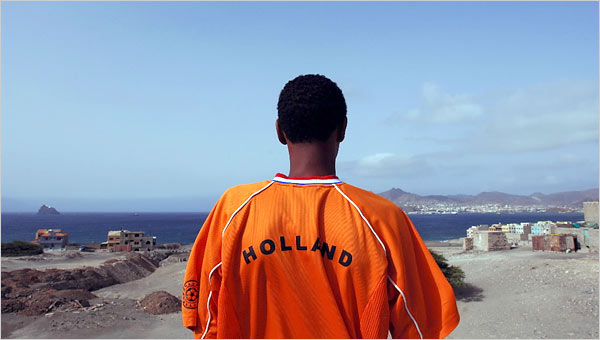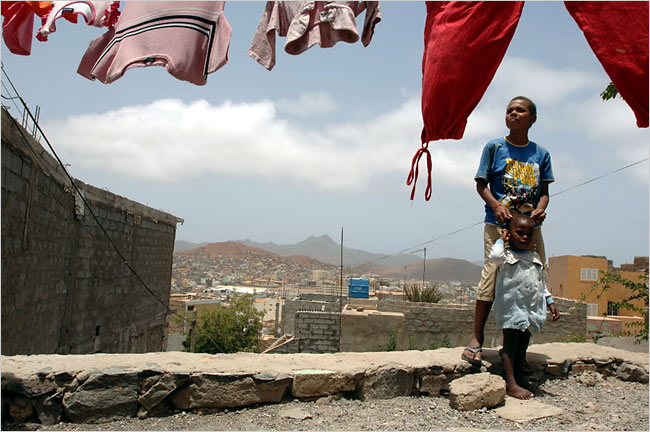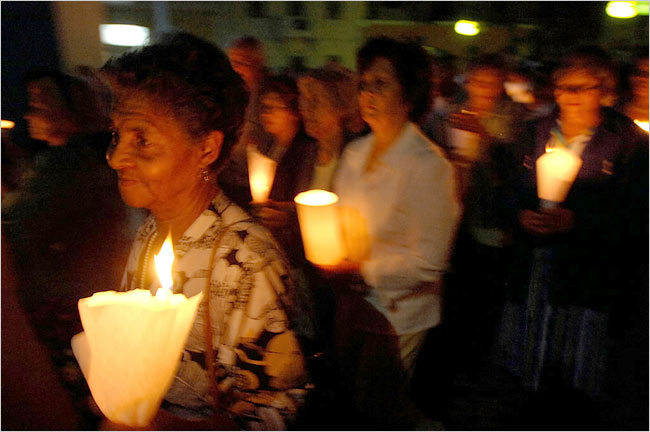| Want to send this page or a link to a friend? Click on mail at the top of this window. |
More Special Reports |
| Posted June 24, 2007 |
| Cape Verde |
| In a World on the Move, a Tiny Land Strains to Cope |
 |
|
James Hill for The New York Times |
|
| Stenio da Luz dos Reis, 17, lives in Cape Verde but longs to join his mother in the Netherland. She left six years ago for a job there. | |
By JASON DePARLE |
MINDELO, Cape Verde — Virtually every aspect of global migration can be seen in this tiny West African nation, where the number of people who have left approaches the number who remain and almost everyone has a close relative in Europe or America.
Migrant money buoys the economy. Migrant votes sway politics. Migrant departures split parents from children, and the most famous song by the most famous Cape Verdean venerates the national emotion, “Sodade,” or longing. Lofty talk of opportunity abroad mixes at cafe tables here with accounts of false documents and sham marriages.
The intensity of the national experience makes this barren archipelago the Galapagos of migration, a microcosm of the forces straining American politics and remaking societies across the globe.
An estimated 200 million people live outside the country of their birth, and they help support a swath of the developing world as big if not bigger. Migrants sent home about $300 billion last year — nearly three times the world’s foreign aid budgets combined. Those sums are building houses, educating children and seeding small businesses, and they have made migration central to discussions about how to help the global poor. A leading academic text calls this the “Age of Migration.”
But it is also the age of migration alarm, as European ships patrol African coasts to intercept human smugglers and new fences are planned along the Rio Grande. Countries that want migrant muscle and brains also want more border control. Many of them see illegal migrants as a security threat, especially in a terrorist age, and worry that large-scale migration, even when legal, can undercut wages, require costly services and subject national identities to bonfires of religious and cultural conflict.
The stakes can be seen here in Mindelo, a semicircle of barren hillsides that gaze out at the only sign of natural life, a beckoning sea. In a country with little rain and a history of famine, migration began as a necessity and became part of the civic DNA. You can dine at Café Portugal, drink at the Argentina bar and stroll Avenida da Holanda.
 |
James Hill for The New York Times |
| Steven Ramos, 11, with one of his nieces in Mindelo, Cape Verde. His Mother works in Portugal, his father in the Netherland. |
Yet Holland — the Netherlands — now requires would-be migrants to pass a test on Dutch language and culture. Other countries have raised the cost of visa applications, discouraged applicants by requiring them to travel to the Cape Verdean capital, Praia, and placed new penalties on employers who hire illegal immigrants. While the Netherlands has long been a favorite destination for residents of this island, a Cape Verdean song now warns that “Holland belongs to the Dutch.”
| Watch out |
| Because they can make you go back |
| swimming |
| And you'll get home with seaweed in |
| your teeth |
Mindelo, Cape Verde’s second-largest city, contains 63,000 people and about as many variations on the migrant’s tale. On the hillside neighborhood of Monte Sessego, Maria Cruz, 70, beams at the living room suite her son sent from Rotterdam. Out toward the airport, Stenio da Luz dos Reis, 17, studies Dutch and hopes to join his mother in the Netherlands. Down by the beach, Orlando Cruz, 46, stares at vacant tables. He fell off a ladder in New Jersey and used the insurance money to start a hotel and restaurant, which are now nearly empty.
As construction racket fills her half-finished house, Evanilda Lopes, 27, speaks freely about the fraudulent papers that got her to the Netherlands. As he hustles change for his H.I.V. medication, Manuel Gomes, 41, is equally frank about the crimes that got him deported from Providence, R.I. He moved there as a child and grew up wild — selling drugs, stealing cars and burglarizing homes. Now like hundreds of others deported here from the United States, he finds himself a man without a country, exiled to a world no less foreign for having been the place of his birth.
“You have a Cape Verdean here who would cut his right arm off to go back,” said Mr. Gomes, who lives in a one-room hovel without running water or electricity.
If Cape Verde is the Galapagos of migration, Jorgen Carling, a Norwegian geographer, is its Darwin. A rising star on the academic circuit, Dr. Carling, 32, visited Cape Verde 10 years ago, taught himself Kriole, the local language, and has been returning ever since.
“Cape Verde is a showcase of the contradictions and frictions of global migration,” he said. “It is in a quite dramatic transition — from being so dependent on migration to trying to cope with a world in which borders are closing.”
The tensions he cites abound. Migration reduces poverty. But it increases inequality between migrants and others back home. Migration can express family devotion. It can also strain family bonds.
And while migration may be at record levels, so is the frustration of people who want to migrate but cannot. That is because as migration grows, the desire to experience its economic rewards grows even faster.
“Migration is probably more important to more people than it has ever been,” said Dr. Carling of the International Peace Research Institute, a nonprofit group in Oslo. “But what characterizes the world today is also the feeling of involuntary immobility.”
These conflicts can be seen in a block home on a dusty hill where migration unites and divides four generations. At 79, the owner, Antonia Delgado, is old enough to remember famines, and she spent decades living in a shanty made of used oil drums. Thanks to the money her son sent from the Netherlands, she has four rooms, electric lights and indoor plumbing.
But she no longer has the son. He stopped calling more than five years ago, and she is not sure if he is alive. “I’m very worried,” she said. “He helped me so much.”
Now she relies on money sent by a second family migrant, her granddaughter Fatima, a nanny in Portugal. That brings Ms. Delgado monthly support of $135, but leaves her raising her granddaughter’s son, an 11-year-old with a missing front tooth and irrepressible smile.
The boy, Steven Ramos, is sorting through parallel complexities. His mother’s salary buys school supplies, martial arts lessons and the occasional DVD. But she left five years ago and has come home only once. His father works in the Netherlands and rarely calls. Steven called him “ingrote” — for ungrateful — choosing a Cape Verdean term for migrants who forget those left behind.
Though Steven’s mother now has a work permit, she cannot get a visa for Steven, who has spent his childhood thinking their reunion was imminent. He cried when her recent visit ended but cast her departure in traditional Cape Verdeans terms, as something natural, necessary and good. “I cried, but I wasn’t sad because I knew she needed to go,” he said. “ She went to give us better conditions.”
| An Identity Linked to Migration |
Without migration, Cape Verde would not exist. The 10-island chain, 385 miles off the coast of Senegal, was uninhabited until the 15th century, when Portugal settled it with two migrant streams — Europeans and African slaves. Cape Verde became a creolized mix of both continents and a supply depot for the slave trade.
 |
James Hill for The New York Times |
| Maria Cruz, left, who took part in a religious festival, has four children who left Cape Verde to work in the United States, Portugal and the Netherland. |
Mass emigration began in the late 1800s on whaling ships that brought Cape Verdeans to New England. It continued after World War II with European guest-worker plans, which sought temporary labor but brought permanent settlement.
Those same plans brought Turks to Germany, South Asians to Britain and North Africans to France, and a generation later, many Europeans remain concerned about continuing cultural conflicts. “We asked for workers, but we got people,” is a famous European lament.
Cape Verde gained independence from Portugal in 1975, about the time the guest-worker plans ended. Still, Cape Verdean migration continued — legally (through family reunification laws) and illegally (through visitors who stay after visas expire). Many people here travel on tourist visas, then seek a European or American citizen to marry, often of Cape Verdean ancestry.
Migration is so central to their identity, Cape Verdeans often boast that emigrants outnumber the people who remain. That is true, Dr. Carling said, only when counting emigrants and their descendants. By that standard, he estimates there are 460,000 Cape Verdeans on the islands and 500,000 overseas, including 265,000 in the United States. “Sodade,” the hit by Cesaria Evora, a Mindelo resident and a Grammy award winner, conveys “longing, longing, longing for my island.”
Some scholars argue that migrants form a record share of the world’s population, though weak data make historical comparisons difficult. Despite current alarm, migration is likely to grow. Rich economies with aging work forces need labor. Workers in poor countries need jobs. Border crossings are hard to prevent, and the rewards of moving have never been greater. The average pay raise awaiting today’s unskilled migrants, in inflation-adjusted terms, is about twice as high as that which greeted migrants a century ago, during the last great period of global migration.
Economists generally argue that migration has helped rich economies expand by supplying needed labor, though some low-skilled domestic workers may suffer wage reductions because of increased competition. From the start, Cape Verde has embraced its emigrants — as kinsmen, investors, lobbyists for foreign aid, safety valves for population growth and eventually as voters. With migrant help, Cape Verde has doubled its per capita income since 1990, to about $2,100, a high figure by African standards. Remittances, the sums that migrants send home, make up 12 percent of the gross domestic product and once were twice as high. Migrants elect their own representatives to the National Assembly.
More broadly, however, development experts are split on the effects of migration. Remittances feed and shelter the poor, and migrants sometimes return with new business contacts and ideas. But migration can also drain countries of talent and promote dependency, among individuals and governments. No country has climbed out of poverty through migration alone. Despite the economic progress here, the unemployment rate hovers above 20 percent and the fastest-growing industry, tourism, is dominated by low-wage jobs.
While Dr. Carling admires Cape Verde’s ability to invent itself as a nation beyond borders, he also sees problems with the constant emphasis on departures. It can weaken relationships, he said, leave marriages short-lived and promote indifference among students and workers. “The possibility of relying on remittances — and the prospect of going abroad one day — can alienate you from the environment here,” he said.
Even as Cape Verdeans struggle to get out, others are migrating in. This, too, is characteristic of the age of migration — most “sending” countries are also “receiving” countries, underscoring how universal the phenomenon is. Nearly half the migrants from poor nations move to other poor nations.
Mindelo, on the island of São Vicente, is filled with Chinese shopkeepers chasing new markets and West African peddlers fleeing homelands torn by war and worse poverty. Many hope to move on to the Canary Islands, which are part of Spain, aboard dangerous smuggling boats on journeys that kill hundreds if not thousands every year.
“This is life and death,” said Emmanuel Kofi Cathline, a local peddler who migrated from Ghana 17 years ago and once made money here helping migrants book the illegal journeys. Though crackdowns have chased him from the business, he remains loyal to what might be called the global migrants’ creed. “If a place is no good, change it,” he said. “Go to another place!”
| A Test of Optimism |
For all the rising barriers, many Cape Verdeans remain confident they will leave. Mr. da Luz dos Reis, the teenager studying Dutch, answered the door in a blaze of sartorial optimism: orange shorts and orange shirt — can you guess the Dutch national color? — with the word “Holland” stretched across his back.
His mother left for the Netherlands six years ago to work as a maid, and his younger sisters just joined her. Having passed his 16th birthday, Mr. da Luz dos Reis was left behind, with a workbook containing 100 questions in Dutch.
Thirty will appear on a test. No. 62 asks if it is important to learn Dutch quickly. (It is.) No. 59 asks if wife beating is permissible. (It is not.) Mr. da Luz dos Reis pays $70 a month for a tutor and must take the test in Dakar, two hours away by plane. But he is not one to gripe.
“It’s good,” he said of the test. “Then we get there with an idea of what it’s like.” Besides, he added, “it’s their country.”
Across town, Evanilda Lopes, 27, has more experience and less optimism. A stylish woman with rhinestones on her Coco T-shirt and blond extensions in her hair, she was raised on reports of fashion and comfort from six older siblings in Europe. She left school at 17 and spent five years seeking a tourist visa, which arrived only after she had created a fictitious bank account and job. “It was the way I could go,” she said.
Things soured in the Netherlands. Her aunt lined up three Dutch men for her to marry, but Ms. Lopes rejected them all. The atmosphere in the house grew hostile. Ms. Lopes moved in with a Dutch plumber, and they had a child they named Giovanni. Cohabitors in the Netherlands have residency rights, but when the relationship expired so did her permission to stay.
She came home last fall with a cache of the luxury goods she had gone to Europe to find — belts, handbags, sandals, perfume. She sold them on the streets and made enough money to start building a home for her and Giovanni, 5, who has just come home to a country he does not know.
Ms. Lopes alternately calls her time in the Netherlands a blessing and a curse. “I was young and I didn’t know life was so hard,” she said. With a half-finished house and half-formed plans, she has her shoes on one shore, her mind on another and her innocence lost somewhere in between.
Copyright 2007 The New York Times Company. Reprinted from The New York Times, International, of Sunday, June 24, 2007.
| Wehaitians.com, the scholarly journal of democracy and human rights |
| More from wehaitians.com |